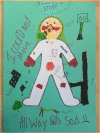Being on the juvenile dermatomyositis rollercoaster: a qualitative study
- PMID: 31215480
- PMCID: PMC6582587
- DOI: 10.1186/s12969-019-0332-7
Being on the juvenile dermatomyositis rollercoaster: a qualitative study
Abstract
Background: Juvenile Dermatomyositis is a rare, potentially life-threatening condition with no known cure. There is no published literature capturing how children and young people feel about their condition, from their perspective. This study was therefore unique in that it asked children and young people what is it like to live with Juvenile Dermatomyositis.
Methods: Data were obtained from fifteen young people with Juvenile Dermatomyositis, between eight and nineteen years of age from one Paediatric Rheumatology department using audio-recorded interpretive phenomenology interviews. Data were analyzed phenomenologically, using a process that derives narratives from transcripts resulting in a collective composite of participants shared experiences, called a 'phenomenon'.
Results: The overarching metaphor of a rollercoaster captures the phenomenon of living with Juvenile Dermatomyositis as a young person, with the ups and downs at different time points clearly described by those interviewed. The five themes plotted on the rollercoaster, began with confusion; followed by feeling different, being sick, steroidal and scared from the medications; uncertainty; and then ended with acceptance of the disease over time.
Conclusion: Young people were able to talk about their experiences about having Juvenile Dermatomyositis. Our findings will aid clinicians in their practice by gaining a deeper understanding of what daily life is like and highlighting ways to enhance psychosocial functioning. Hopefully, this study and any further resulting studies, will raise understanding of Juvenile Dermatomyositis worldwide and will encourage health care professionals to better assess psychosocial needs in the future.
Keywords: Juvenile dermatomyositis; Phenomenology; Psychosocial needs; Qualitative research; Uncertainty.
Conflict of interest statement
The authors declare that they have no competing interests.
Figures


References
MeSH terms
Substances
Grants and funding
LinkOut - more resources
Full Text Sources

